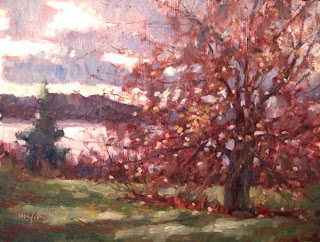These projects require that we increase our burden beyond a couple of suitcases. (Am I possibly violating key principles of "backpacker painting"?) I'm taking two complete painting set-ups, one each for oil and pastel; backup supplies of oil paint and panels, pastels and paper; a digital video camera as well as a digital SLR still camera and an assortment of lenses and tripods; and finally, a laptop with every document and database I thought I might possibly need, as well as a pair of headphones for Skype. In order to save space, I was a bit stingy with the art supplies. I'm planning on placing a big order with Cheap Joe's once I arrive in Sedona.
It seems like we've been piling up our belongings for days in preparation for packing the car. Fortunately, my other projects ended last week, and I've had some time in which to mull over what else I might need. There are so many things that might have become afterthoughts a thousand miles down the road: "Oh, what about the USB mouse for the laptop?" The mouse is now on my list of things to stuff into a box at the last minute. I hope we still have room for clothes and Saba the Dog.
"Rainy Day Birches" 5x7, pastel
Yesterday, I took a few minutes off to do a small study of the birches in the backyard. It was pouring rain, but this only made the colors even more fantastic. I worked inside, looking out. As you can see, I took a very loose approach with this piece and had fun with the color. Some of you might notice that this is another painting in my "Yellow Barn, Yellow House" series. You can see those two structures in the background.
This will be my last post for awhile. I hope to post again between December 8-12, when I'll be teaching a workshop in Sarasota, Florida. Until then, happy trails!










